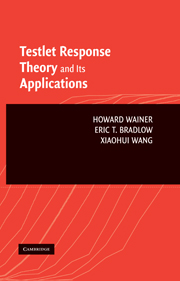Book contents
- Frontmatter
- Contents
- Preface
- PART I INTRODUCTION TO TESTLETS
- PART II BAYESIAN TESTLET RESPONSE THEORY
- 7 A brief history and the basic ideas of modern testlet response theory
- 8 The 2-PL Bayesian testlet model
- 9 The 3-PL Bayesian testlet model
- 10 A Bayesian testlet model for a mixture of binary and polytomous data
- 11 A Bayesian testlet model with covariates
- 12 Testlet nonresponse theory: dealing with missing data
- PART III TWO APPLICATIONS AND A TUTORIAL
- Glossary of terms
- Epilogue
- Bibliography
- Author Index
- Subject Index
7 - A brief history and the basic ideas of modern testlet response theory
Published online by Cambridge University Press: 08 January 2010
- Frontmatter
- Contents
- Preface
- PART I INTRODUCTION TO TESTLETS
- PART II BAYESIAN TESTLET RESPONSE THEORY
- 7 A brief history and the basic ideas of modern testlet response theory
- 8 The 2-PL Bayesian testlet model
- 9 The 3-PL Bayesian testlet model
- 10 A Bayesian testlet model for a mixture of binary and polytomous data
- 11 A Bayesian testlet model with covariates
- 12 Testlet nonresponse theory: dealing with missing data
- PART III TWO APPLICATIONS AND A TUTORIAL
- Glossary of terms
- Epilogue
- Bibliography
- Author Index
- Subject Index
Summary
Introduction. Testlets as a multidimensional structure
One useful way to think about a test built of k testlets utilizes factor analytic vocabulary (Gessaroli & Folske, 2002). First, we note that all of the testlets contain information about the underlying trait of interest – a general factor. However, each of the items within a testlet also has some connection with the other items in that testlet, over and above the general factor – a testlet-specific factor. Thus, the factor structure of such a test has k + 1 orthogonal factors; a general factor, plus one factor for each testlet.
The story that describes a theoretical test structure, and its associated mode of analysis based on this concept, begins in 1937 with the publication of Karl Holzinger and Francis Swineford's bi-factor method. Holzinger and Swineford (1937) conceived of the bi-factor method as an extension of Spearman's two-factor model, and its character matched the conceptual structure that Thurstone had for his primary mental abilities (Thurstone, 1938). Specifically, they thought of the underlying structure of a bank of tests as consisting of a single general factor and each set of tests loading on its own specific factor. They illustrated this with a bank of 15 tests that all load on a single general factor of ability, but, in addition, had four tests that loaded on a spatial factor, three other tests that loaded on a mental speed factor, four tests on a motor speed factor, and the remaining four tests on a verbal factor.
- Type
- Chapter
- Information
- Testlet Response Theory and Its Applications , pp. 110 - 117Publisher: Cambridge University PressPrint publication year: 2007



